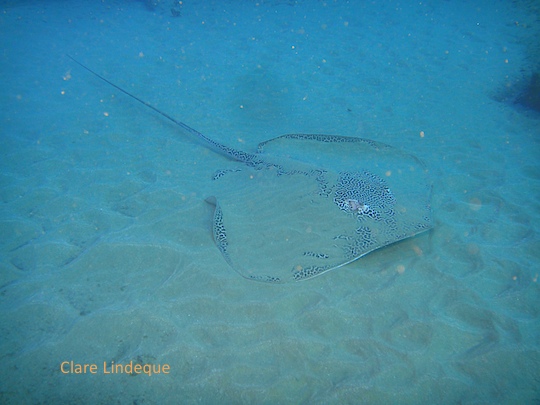
Texas is named because of its size (it’s big), and dives there may incur a small surcharge because the boat ride is longish. It’s in the next bay on from Ponta do Ouro, called Malongane bay, which where the small town of Ponta Malongane can be found (unsurprisingly). It’s quite close to shore, so we dived it on a day when the swell was almost nonexistent. The inshore side of the reef is made up of massive rectangular boulders that form channels and overhangs that shelter countless fish. The regular structure of the reef is very striking, and there are many, many places to explore under and between the rocks. There’s a huge channel down the centre of the reef, almost dividing it in two.

We spent most of the dive on the inshore side of the reef, which is quite steep and rocky. We were distracted for some time by a large, friendly potato bass who approached our group of divers and then lay blissfully while our divemaster, and then Tony, tickled his chin with air from their octos. He also stared into Tony’s camera for some time, perhaps admiring his noble reflection. I was very sad to leave him (is he lonely?) and turned back a few times to see him following us at a small distance.

Texas has beautiful corals and provides abundant habitat for reef fish, which we found in hotspots all over the reef, interspersed with sand. There are larger creatures too – including the potato bass I’ve already told you about. We saw a honeycomb moray eel under an overhang on the seaward side of the reef, and this beautiful honeycomb stingray (his tail is incredibly long – there’s another picture of him here) lying on the sand.

See if you can find Texas on this very nifty map of the Ponta reefs.

Dive date: 10 May 2012
Air temperature: 24 degrees
Water temperature: 24 degrees
Maximum depth: 13.8 metres
Visibility: 12 metres
Dive duration: 64 minutes





















All the underwater shots look fabulous! Because of the wonderful pictures in this site, I can now officially say that I am (starting to be) fascinated by potato bass. They look adorable!;) That shot with Tony is really cool. Why are they called potato bass by the way? I can’t find any resemblance or connection with that fish and a potato.Haha.:)
Hi Jean, thank you! I have no idea where the name potato bass comes from… Google is unhelpful, maybe it’s because of the texture of the fish’s flesh or something (which is not a nice thought once you’ve dived with them)!